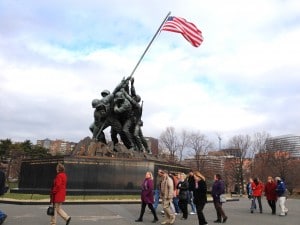
This article was originally published in Student Group Tour Magazine in January 2014.
A cloud of silence fills the bus.
Although fifty-five sets of eyes are fixated on the uniform marble tombstones of Arlington National Cemetery passing by their windows, the hearts and minds of their owners are elsewhere. They are a collection of eighth grade boys and chaperones, all lost in their thoughts of the boy they once were, the boys they are, or the boys they call sons.
 A few of the students just read aloud to the bus James Bradley’s “The Boys of Iwo Jima”. Please take a minute to read it, if you never have. It poignantly captures the personalities and fates of the six boys who raised the American flag on Mount Suribachi during World War II .
A few of the students just read aloud to the bus James Bradley’s “The Boys of Iwo Jima”. Please take a minute to read it, if you never have. It poignantly captures the personalities and fates of the six boys who raised the American flag on Mount Suribachi during World War II .
As they exit the bus, the students shake hands with the Marine who also happens to be our motor coach driver. Transformed before their eyes, the Marine Corps Memorial is no longer a detached tribute to unattainable heroism, but rather a sculpture of boys just like themselves who were brave when it mattered most.
A great story can transform a student tour from merely a visit to an enduring point of education and deep emotional connection. Dates and figures are quickly forgotten, but it is the great stories that are remembered. Engaging stories and hands-on experiences are what make a location real for students, what they return home talking about, and what creates a lasting impact.
Several elements to keep in mind as you craft your next story are:
1. Make It Personal. Great stories create emotional connections for the audience and resonate with their worldview. For you to understand the right perspective, get to know your audience. Learn their names, talk with them about their home town, ask what sports they are involved in, if they have any siblings, where they have traveled before, etc. Add relevant details or comparisons to your stories. The important thing is for them to feel like they, or someone they know well, could be a character in the story.
2. Weave in the Facts. Instead of listing facts about a particular memorial or destination site, weave them into your story as well as additional historical context. Important information is imparted without losing the audience’s attention.
3. Be Interactive. Involve the students in the story. Engage them with questions  and encourage them to act as a character. Print a tale on note cards and have students read their portions. Encourage applause for those involved.
and encourage them to act as a character. Print a tale on note cards and have students read their portions. Encourage applause for those involved.
4. Invoke the Senses. Words devoted to smells add dimension to a story. Words such as “cinnamon,” “soap,” or “mint” add a layer of sensory experience and paint a more vivid scene for the students.
5. Keep it Short. Stories that keep the audience’s attention are clear throughout, with an introduction, development, and swift conclusion.
6. Keep it Simple. Use simple, uncomplicated language throughout the story. Low complexity language helps the audience to focus on and better relate to the happenings of the story.
Crafting engaging stories is a skill developed intentionally over time. Carefully selected and timely stories connect students with their destination in a meaningful way, transforming their class trip into an exciting learning experience.





















